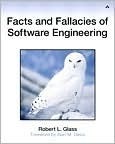What do you think?
Rate this book


The practice of building software is a “new kid on the block” technology. Though it may not seem this way for those who have been in the field for most of their careers, in the overall scheme of professions, software builders are relative “newbies.”
In the short history of the software field, a lot of facts have been identified, and a lot of fallacies promulgated. Those facts and fallacies are what this book is about.
There’s a problem with those facts–and, as you might imagine, those fallacies. Many of these fundamentally important facts are learned by a software engineer, but over the short lifespan of the software field, all too many of them have been forgotten. While reading Facts and Fallacies of Software Engineering, you may experience moments of “Oh, yes, I had forgotten that,” alongside some “Is that really true?” thoughts.
The author of this book doesn’t shy away from controversy. In fact, each of the facts and fallacies is accompanied by a discussion of whatever controversy envelops it. You may find yourself agreeing with a lot of the facts and fallacies, yet emotionally disturbed by a few of them! Whether you agree or disagree, you will learn why the author has been called “the premier curmudgeon of software practice.”
These facts and fallacies are fundamental to the software building field–forget or neglect them at your peril!
224 pages, Kindle Edition
First published October 1, 2002
A light reading … the author draws from his long experience as a practitioner and a researcher. The book is neither academically dry nor rockie trivial. The author categorized the facts in parts and sections, where each part and section has a kind of an argument that loosely connects them all. He draws from his research and others to back up his arguments, but he doesn’t go down much into discussing the papers.
This book did age well. It may not be the most famous out there, but it’s known okay. If you have some experience and you read this, you will have probably read most of them in other sources. But it’s still a good refresher; it offers a good discussion and, throughout the facts, it challenges some of the prevalent ideas in the industry. And it’s a light read!
Some of the opinions that contribute and are connected to many of the facts and that you could discern clearly (and Glass did affirm them in the conclusion):
People are more important to the success of a software product than tools or processes. Studies even found that the ratio of a good programmer’s performance to mediocre one could reach 28 to 1.
Software is complex; and many management decisions and software research trends tend to employ simplistic approaches that ignore or fail to meet such complexity. This is connected to the first point, because good software developers are much more capable to tackle that complexity, and it’s connected to many of what the author discussed about runaway projects and difficulties of software delivery and maintenance.
Schedule pressures are the biggest hurdle put by management against success of software projects. Bob Glass really has an ax to grind about this one!
Reality is the murder of a beautiful theory by a gang of ugly facts.